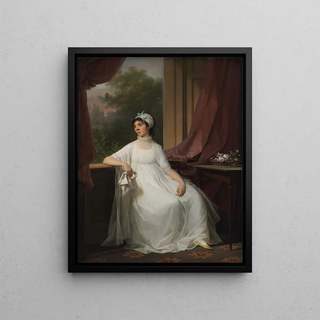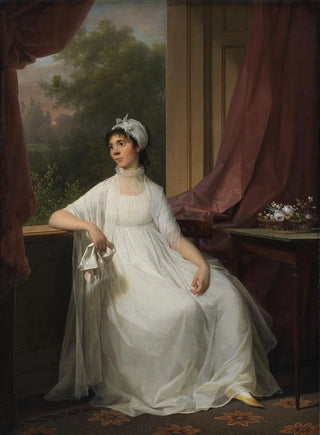Art print | Portrait of Gertrud Hage and Heitmann - Jens Juel


View from behind

Frame (optional)
The "Art print of Gertrud Hage et Heitmann" by Jens Juel is a work that transcends the simple frame of an artistic representation to become a true testament to its era. Immersing oneself in this painting, the viewer is immediately transported to 18th-century Denmark, a period marked by cultural vibrancy and a pronounced taste for portraiture. The delicacy of the features, the finesse of the details, and the expressiveness of the faces are all elements that make this piece captivating. It does not merely capture the appearance of its subject but also evokes an atmosphere, a story, and an intimacy that invite contemplation.
Style and uniqueness of the work
Jens Juel's style is distinguished by its striking realism and his ability to breathe palpable life into his subjects. In "Art print of Gertrud Hage et Heitmann," light plays a crucial role, highlighting the textures of fabrics and the nuances of skin. The composition is carefully balanced, with each element having its place within a harmonious whole. The artist manages to create an emotional connection between the viewer and the characters, making their gaze almost alive. The richly detailed clothing not only reflects Gertrud's social status but also the ease and taste of the period. Juel succeeds in combining impeccable technique with sensitivity, making this work an emblematic example of portrait painting of his time.
The artist and his influence
Jens Juel, a prominent figure in Danish painting, established himself as a master of portraiture in the 18th century. Trained in France, he was influenced by the great European masters but developed a style that is uniquely his own. His talent allowed him to paint the elites of his era, thus leaving a mark on Danish art history. Juel not only contributed to the rise of portraiture as an artistic genre but also paved the way for many artists who followed. His ability to capture the essence of his models made him an essential reference, and his legacy endures to this day. Through "Art print of Gertrud Hage et Heitmann,"

Matte finish

View from behind

Frame (optional)
The "Art print of Gertrud Hage et Heitmann" by Jens Juel is a work that transcends the simple frame of an artistic representation to become a true testament to its era. Immersing oneself in this painting, the viewer is immediately transported to 18th-century Denmark, a period marked by cultural vibrancy and a pronounced taste for portraiture. The delicacy of the features, the finesse of the details, and the expressiveness of the faces are all elements that make this piece captivating. It does not merely capture the appearance of its subject but also evokes an atmosphere, a story, and an intimacy that invite contemplation.
Style and uniqueness of the work
Jens Juel's style is distinguished by its striking realism and his ability to breathe palpable life into his subjects. In "Art print of Gertrud Hage et Heitmann," light plays a crucial role, highlighting the textures of fabrics and the nuances of skin. The composition is carefully balanced, with each element having its place within a harmonious whole. The artist manages to create an emotional connection between the viewer and the characters, making their gaze almost alive. The richly detailed clothing not only reflects Gertrud's social status but also the ease and taste of the period. Juel succeeds in combining impeccable technique with sensitivity, making this work an emblematic example of portrait painting of his time.
The artist and his influence
Jens Juel, a prominent figure in Danish painting, established himself as a master of portraiture in the 18th century. Trained in France, he was influenced by the great European masters but developed a style that is uniquely his own. His talent allowed him to paint the elites of his era, thus leaving a mark on Danish art history. Juel not only contributed to the rise of portraiture as an artistic genre but also paved the way for many artists who followed. His ability to capture the essence of his models made him an essential reference, and his legacy endures to this day. Through "Art print of Gertrud Hage et Heitmann,"






